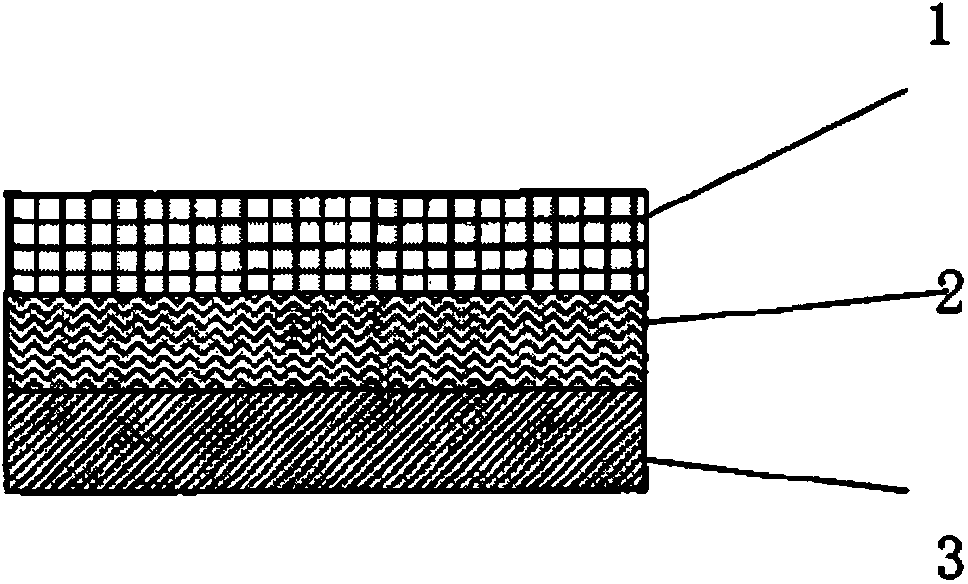Flame-retardant acetate fiber tape and preparation method of acetate fiber
A technology of cellulose acetate and cellulose acetate cloth, which is applied in the direction of artificial filaments, adhesives, film/sheet-like adhesives made of cellulose derivatives, etc., can solve the problem of low spinning efficiency and plasticizer exudation. Or volatilization, poor mechanical properties and other problems, to achieve the effect of easy control of process parameter selection, good mechanical properties and fracture strength, and flexible process parameter selection
- Summary
- Abstract
- Description
- Claims
- Application Information
AI Technical Summary
Problems solved by technology
Method used
Image
Examples
Embodiment 1
[0040] (1) Crush cellulose acetate with a degree of substitution of 2.2, a degree of polymerization of 260, and a weight-average molecular weight of 181,800 to 280 mesh, and after drying, mix with 1-butyl-3-methylimidazolium tetrafluoroborate (BMIMBF4) according to The mass fraction ratio is 2:1 and mixed evenly. The mixture is fed into a twin-screw blender for blending, extrusion, and slicing. The twin-screw blender uses co-rotating screws for blending and extrusion. The temperatures of the feeding section, the melting section, the metering section and the head are respectively 160 ° C to 170 ° C. ℃, 170 ℃, 160~170 ℃, 160 ℃, the speed of the extruder is 10~50 rpm. A colorless and transparent spinning raw material was obtained.
[0041] (2) Put the spinning material into a vacuum oven, and dry it continuously under vacuum for 70 hours at 60°C;
[0042] (3) The spinning material is melt-spun after metering, and the spinning temperature is 170°C. The spinneret hole of the spi...
Embodiment 2
[0045] (1) Crush cellulose acetate with a degree of substitution of 2.3, a degree of polymerization of 360, and a weight-average molecular weight of 235,000 to 250 mesh, and after drying, mix with 1-butyl-3-methylimidazolium tetrafluoroborate (BMIMBF4) according to The mass fraction ratio is 2:1 and mixed evenly. The mixture is fed into the twin-screw blender for blending, extrusion, and slicing. The twin-screw blender uses co-rotating screws for blending and extrusion. The temperatures of the feeding section, the melting section, the metering section and the head are respectively 170 ° C to 180 ° C. °C, 190 °C, 160~170 °C, 160 °C, the speed of the extruder is 50~120 rpm. A colorless and transparent spinning raw material was obtained.
[0046] (2) Put the spinning material into a vacuum oven, and dry it continuously under vacuum for 70 hours at 60°C;
[0047] (3) The spinning material is melt-spun after metering, and the spinning temperature is 190°C. The spinning speed was...
Embodiment 3
[0050] (1) Crush cellulose acetate with a degree of substitution of 2.6, a degree of polymerization of 1000, and a weight-average molecular weight of 400,000 to 300 mesh, and after drying, mix with 1-butyl-3-methylimidazolium tetrafluoroborate (BMIMBF4) according to The mass fraction ratio is 7:1 and mixed evenly. The mixture is fed into the twin-screw blender for blending, extrusion, and slicing. The twin-screw blender uses co-rotating screws for blending and extrusion. The temperatures of the feeding section, the melting section, the metering section and the head are respectively 230 ° C ~ 240 ° C ℃, 240℃, 230~240℃, 230℃. The speed of the extruder is 10 to 30 rpm. A light yellow transparent spinning raw material was obtained.
[0051] (2) Put the spinning material into a vacuum oven, and dry it continuously under vacuum for 30 hours at 120°C;
[0052] (3) The spinning material is melt-spun after metering, and the spinning temperature is 260°C. The spinning speed was 500 ...
PUM
| Property | Measurement | Unit |
|---|---|---|
| Breaking strength | aaaaa | aaaaa |
| Breaking strength | aaaaa | aaaaa |
| Breaking strength | aaaaa | aaaaa |
Abstract
Description
Claims
Application Information
 Login to View More
Login to View More - Generate Ideas
- Intellectual Property
- Life Sciences
- Materials
- Tech Scout
- Unparalleled Data Quality
- Higher Quality Content
- 60% Fewer Hallucinations
Browse by: Latest US Patents, China's latest patents, Technical Efficacy Thesaurus, Application Domain, Technology Topic, Popular Technical Reports.
© 2025 PatSnap. All rights reserved.Legal|Privacy policy|Modern Slavery Act Transparency Statement|Sitemap|About US| Contact US: help@patsnap.com

